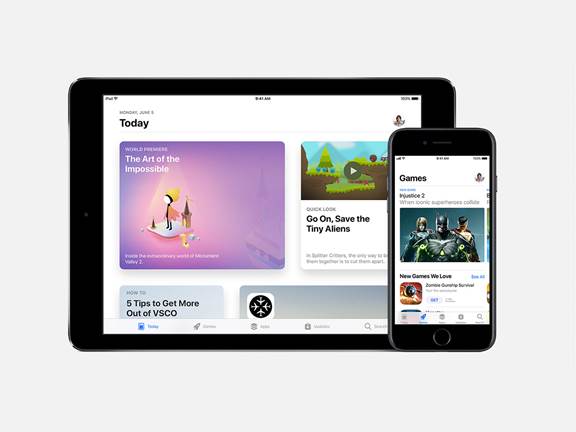The redesign of the nine year old Apple App Store was possibly the most immediately impactful announcement to come out of WWDC last week. Developers are going need to think differently about a broader range of content, owned both by themselves and Apple, when launching an app or trying to grow their users. Having a really (really) strong go-to-market and user growth strategy has never been more important for app promotion.

Apple App Store changes will transform the app promotion rules

A closer look at layout
The App Store is getting an Apple Music-style redesign when iOS 11 launches publicly in autumn, moving to the card-based layout that looks to be Apple’s style going forward. The new store features five tabs: the Updates and Search tabs carry over from the current version, while tabs for Today, Games, and Apps have been added. These three new tabs are now the key places for discovery in the redesign, and are also where Apple’s curated lists and expanded editorial content will appear.
The Today tab will house most of Apple’s new editorial content, which is the main focus of the update. The cards layout means that the first screen will now effectively hold just 2-3 apps: a significant reduction on what was available previously - in turn, making it more important than ever to ensure your app search strategy includes featured.
As well as now having their own tabs, Games and Apps have now been split into two. This should help non-game apps with discovery, and both tabs will present new apps curated by Apple as well as resurfacing older apps. These curated, editorial front pages mean that algorithmically ranking apps has taken a back seat. So, for example, while both Games and Apps have kept the top paid and top free charts, which rank by download numbers, they’re now buried inside those tabs - rather than being accessible from the main screen. The top grossing chart, which ranked based on in-app purchase revenue, has disappeared completely.
While splitting games from apps will help discoverability, the key takeaway for developers is that Apple is becoming more influential in which apps are downloaded than ever before. A combination of fewer apps on screen and more editorial content means that the value of being featured for app promotion is greater than it ever has been.
The rise and rise of editorial content
As indicated above, the App Store is transforming into a fundamentally editorial experience where Apple will have greater influence over what customers download. Content is front and centre - while charts and search are either further out, or in the case of the top grossing chart, removed entirely.
In addition to featuring apps as they do now, via previews, premieres and best of lists, Apple will have new App and Game of the Day selections on their respective tabs. Apple will also be creating two primary kinds of long-form content for the Store:
- Daily stories and feature content, including Meet the Developer, Behind the Scenes, and What’s on My iPhone;
- Instructional content, such as How To, The Basics, Life Hack, or Pro Tip.
Apple is asking developers to submit their story 6-8 weeks in advance, if they have notable launches or feature updates, for possible inclusion in an editorial piece. In a significant change, in-app purchases will now also be eligible for promotion through featuring or long-form content, just like any other app or notable update.
With Apple’s increased influence over the Store, marketing and launch strategies will need to address editorial content. Thinking about how to get an app, whether on launch or on a notable update, into one of the editorial pieces is going to be increasingly important when it comes to driving downloads.
Decoupled ratings and reviews
The star rating system has now been decoupled from the update system. Ratings now carry over across updates - so the rating system now better reflects the overall app, and not just its current version. Developers can now choose when to reset their ratings, enabling them to wipe the slate clean and start again on significant updates.
With this change, developers will now be free to release updates more frequently - as they won’t automatically reset an app’s ratings. Knowing when to push the reset button is also going to become important, especially for more established apps, balancing the value of the updated experience against the opinions of older users.
Apple is also making significant changes to the way apps can use review prompts. They will now be mandating use of their own standard API, introduced in iOS 10.3. This lets users enter ratings and reviews without switching to the App Store - but apps cannot now use any custom review prompts. The standardised prompts are also much more restricted in terms of when you can deploy them; they can only appear three times a year, and if a user submits a review, they won't show up again for at least a year - regardless of what updates are made. Users will also be able to turn off review prompts completely across all apps in iOS11 by activating an option in settings.
Cumulatively, prompts are going to become a far less effective tool for gathering user reviews. Assuming users don’t disable them entirely, optimising for the right moments in the experience to gather positive reviews will become key to ensuring they are used effectively.

Richer product pages
Content is also the big focus of the updated product pages. App preview videos will now auto play on product pages, with developers now being able to include up to 3 on their product page. Users on earlier versions of iOS will only see the first video, maintaining backward compatibility with older versions - not that fragmentation is much of an issue.
Apple have added a new subtitle field for apps, which will appear in charts as well as the product page. Limited to 30 characters, the addition of this field compensates for a shortening of the main app name to 30 characters. The subtitle field will also be indexed for search results.
Developers will now also be able to include promo text, similar to the Google Play Store. This text, consisting of a maximum of 170 characters, will appear above the description in the product page. It can be changed at any time without submitting an app update through the review process. This means it can be effectively used for timely promotions. By contrast, the description field can no longer be updated without submitting an update for review - which may be a prelude to it becoming indexed for search results.
Optimising for the new product page format is going to require more investment in video content than the current format. A wider range of elements being indexed for search will need to be factored in, especially considering the increased value of appearing at the top of a search query.
App Search
Search is also getting some tweaks, as well as something of a demotion, as part of the redesign. It’s now the final tab on the App Store, with updates moving ahead of it. Apple’s paid search ads are still there, with recommended ‘trending’ search queries now listed underneath the search bar.
Despite its demotion on the Store, app search optimisation is going to be more critical if you aren’t able to get into the more limited number of featured apps, or appear in the editorial content.
In-app purchases can now also be searched directly from the search bar, and will appear as recommended search queries.
Appearing at the top of search queries is going to be more important if you can’t get your app into the editorial content. Making effective use of Apple’s Search Ads, launched last year, will help developers drive acquisition.
For further information, be sure to check out: https://www.apple.com/newsroom/2017/06/apple-unveils-all-new-app-store/